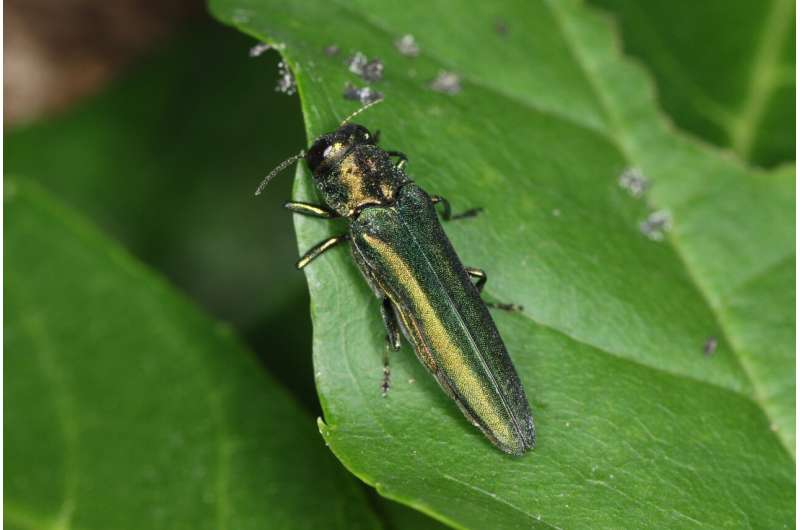This article has been reviewed according to Science X's editorial process and policies. Editors have highlighted the following attributes while ensuring the content's credibility:
fact-checked
peer-reviewed publication
proofread
Hope for the ash tree: Trees resistant to ash dieback are also resistant to beetles

The invasive fungal disease ash dieback has already affected 90% of ash trees in Central Europe. In addition, an invasive beetle threatens the trees. But there is now good news: trees that are resistant to the fungus are also better able to withstand the beetle, as a trial led by the Swiss Federal Institute for Forest, Snow and Landscape Research WSL shows.
Ash dieback was devastating for what used to be Switzerland's second most common deciduous tree species. More than 90 percent of ash trees fell ill and young trees in particular died in large numbers. The causative agent of the disease is a fungus originating from Asia called Hymenoscyphus fraxineus, which has been detected in Switzerland since 2008.
Another ash tree killer is approaching from the same direction, the emerald ash borer (Agrilus planipennis), which was introduced to Russia from East Asia in 2003. Since then, it has been spreading westwards. The larvae that develop inside the tree are deadly to ash trees.
One small ray of hope is that foresters keep discovering healthy-looking ash trees in their forests that are apparently resistant to the fungus. An international research team led by WSL collected branches from fungus-resistant and fungus-susceptible ash trees in Switzerland, Sweden and Denmark. They grafted these twigs onto understocks and thus grew new saplings. They exposed these to both the fungus and the beetles in WSL's high-security greenhouse (biosafety level 3).
Glimmer of hope for ash trees
In fact, they found that on ash trees that were more resistant to the fungus, the beetles also grew more poorly. This is called cross-resistance, and it is a glimmer of hope for ash trees. "This result is encouraging," states study leader Michael Eisenring, who has now published the result together with his colleagues in the journal New Phytologist. "For example, fungus-resistant ash trees could be planted to make it more difficult for both the fungus and the beetle to advance."
In fungus-resistant ash trees, the beetles gained less weight and developed more slowly. The research team suspected that fungus-resistant plants produce certain defense substances that are effective against both the fungus and the beetle. So they studied the chemical composition of the tree sap, which transports sugars and other substances between plant parts. The beetles feed on this sap in the tree trunk. Indeed, the chemistry in the sap differed between more and less resistant ash trees and also explained the differences in weight of the beetles. These are phenolic substances, which are known defense substances.
Such trees will not stop the beetle, says Eisenring. But they might slow it down. It also gives researchers time to train sniffer dogs on the beetles, for example, or to find natural antagonists against the two ash-killers.
One such possibility could be parasitic wasps that lay their eggs in beetle larvae. Therefore, the task now is to get as many of the resistant ash trees as possible into the forests. However, no one yet knows whether the resistant ash trees will also work well economically and ecologically. So the rescue of the ash tree is far from being accomplished.
More information: Martin M. Gossner et al, A glimmer of hope—ash genotypes with increased resistance to ash dieback pathogen show cross‐resistance to emerald ash borer, New Phytologist (2023). DOI: 10.1111/nph.19068
Journal information: New Phytologist
Provided by Swiss Federal Institute for Forest, Snow and Landscape Research WSL

















